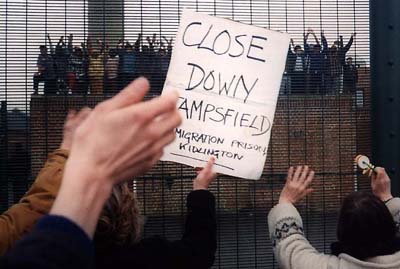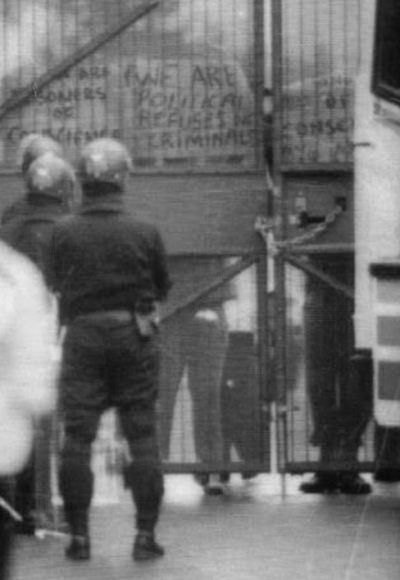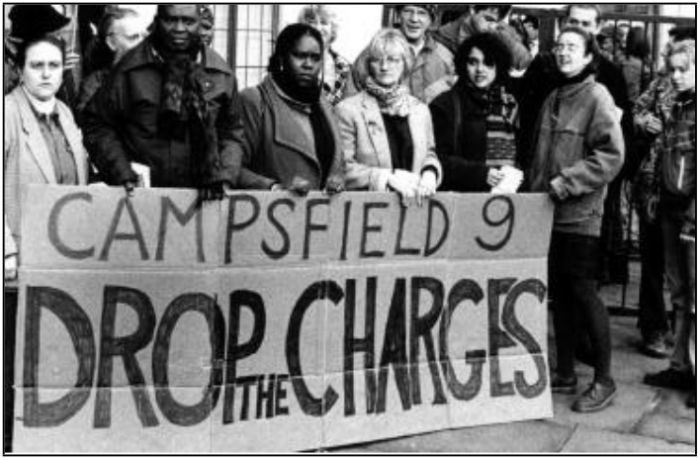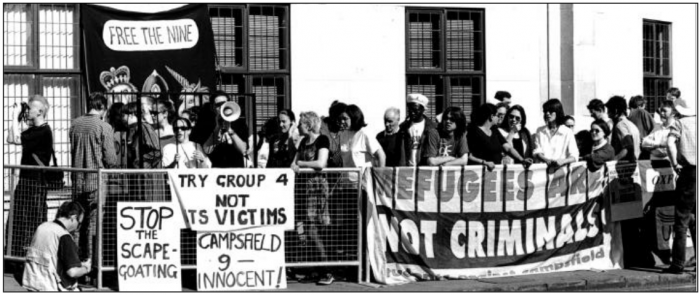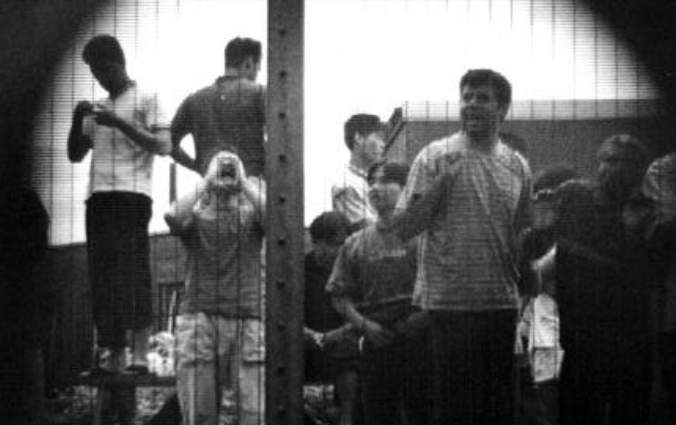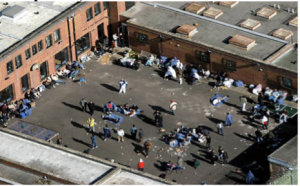Difference between revisions of "Campsfield House IRC"
Phil Miller (talk | contribs) (→1997 protests) |
Phil Miller (talk | contribs) (→1998 Campsfield Nine trial) |
||
| Line 47: | Line 47: | ||
[[Image:Campsfield-9-protest-Oxford-Crown-Court-preliminary-hearing-9 2 1998.png|700px|center|thumb|'''Campsfield Nine supporters rally outside Oxford Crown Court for a preliminary hearing, 9 February 1998 (Campaign to Close Campsfield)''']] | [[Image:Campsfield-9-protest-Oxford-Crown-Court-preliminary-hearing-9 2 1998.png|700px|center|thumb|'''Campsfield Nine supporters rally outside Oxford Crown Court for a preliminary hearing, 9 February 1998 (Campaign to Close Campsfield)''']] | ||
| − | + | ||
| + | The defendants' lawyers found serious contradictions in the [[Group 4]] witnesses' testimonies, drawing on CCTV footage. The trial collapsed, with the prosecution telling the court that it could no longer recommend a guilty verdict to the jury. However, several of the Nine are detained in Rochester prison after the trial pending deportation. | ||
[[Image:Campsfield-9-trial-opens-Oxford-Crown-Court-1 6 1998.png|700px|center|thumb|'''Campsfield Nine supporters rally outside Oxford Crown Court at the first day of the trial, 1 June 1998 (Campaign to Close Campsfield)''']] | [[Image:Campsfield-9-trial-opens-Oxford-Crown-Court-1 6 1998.png|700px|center|thumb|'''Campsfield Nine supporters rally outside Oxford Crown Court at the first day of the trial, 1 June 1998 (Campaign to Close Campsfield)''']] | ||
Revision as of 18:04, 26 November 2015
Campsfield House IRC is an immigration removal centre
Contents
- 1 List of centre managers
- 2 History
- 2.1 1993 Campsfield opens under Group 4
- 2.2 1994 hunger strike
- 2.3 1995 protests
- 2.4 1996 escape attempt
- 2.5 1997 protests
- 2.6 1998 Campsfield Nine trial
- 2.7 1999 injuries and protests
- 2.8 2000 protests
- 2.9 2001 fire
- 2.10 2002 escape, closure announcement and u-turn
- 2.11 2003 inspection
- 2.12 2005 death in detention
- 2.13 2006 Geo take over
- 2.14 2007 escape and fire
- 2.15 2008 fire and escape
- 2.16 2009
- 2.17 2010
- 2.18 2011 - Mitie takes over
- 2.19 2012 hunger strike
- 2.20 2013 fire
- 2.21 2014 hunger strike
- 3 Notes
List of centre managers
- Joanne Henney from July 2006 to June 2009
- Alex Sweeney from 2009 to April 2010
- Paul Morrison from 2011 to early 2014
- Andrew Simpson to June 2014
- Neil Aubeelack from June 2014
History
1993 Campsfield opens under Group 4
Campsfield was opened as an immigration detention centre in November 1993, run by Group 4. It used to be a borstal. The first detainees were brought from Harmondsworth IRC.
1994 hunger strike
Early in 1994, ten Algerians (including one woman) staged a successful hunger strike at Campsfield and were released.[1] Following this, 180 out of 200 detainees at Campsfield went on hunger strike. Several of them gained access to the roof and communicated with demonstrators outside the centre. This sparked hunger strikes at other centres and prisons. In March, detainees at Campsfield protest on the roof. The authorities reacted by moving 15 so called ring leaders from Campsfield to Winson Green, Bullingdon and Blakenhurst prisons. Some were put in segregation cells and two were put on suicide watch in bare cells. All of the 'ringleaders' ended up in hospital and were not released from detention. The last hunger striker stops after 41 days.[2]
In June, there was an uprising at Campsfield following the deportation of former hunger strike Ali Tamarat without any warning, despite previous assurances by the immigration staff. Detainees protest on the roof and several escape. [3] Riot police moved 22 detainees to prison, and at least five detainees are injured.
Later in 1994, Ghanaian detainees went on hunger strike. Despite an official ban on using gags after the death of Joy Gardner, a Campsfield detainee is bound, gagged and deported to Ghana.
1995 protests
A successful hunger strike in February saw detainees win access to halal food and a change to meal times so Muslim detainees could observe Ramadan.
In March, two detainees (Anne-Marie Sonan and Sita Kamara) are released after a hunger strike. However, two other detainees were deported in May despite being on hunger strike for over 30 days and being too weak to walk. One was subsequently hospitalised in India for several weeks.
1996 escape attempt
Six detainees try to escape but are caught and transferred to prison
1997 protests
"In May 1997, when an Algerian falsely accused of sexual harassment was removed to Winson Green prison, his friends, after spending the morning "talking and talking", decided to climb onto a roof to demand his return. They stayed on the roof all night and most of the next day, with a little food and some blankets passed up to them by detainees below. About one hundred other detainees, refusing to be locked into their rooms, broke out into a courtyard and were eventually locked into another wing. Extra Group 4 guards were bussed into Campsfield in riot gear. Eventually the rooftop protesters were forced down by the cold and the rain. They were transferred to Winson Green, Rochester and Tinsley House.
On August 20 1997, there was another mass protest, triggered by the early morning removal of two West African detainees. One of them was ill, resisted and woke everybody with his cries of pain. The detainees who saw his removal thought he was being strangled, and demanded to know why the two were being removed. Eventually nearly all of the detainees were outside in the courtyard protesting and displaying placards saying they were not criminals.
Parts of the inside of the building were smashed and set ablaze. Group 4 guards withdrew, donned their riot gear, numerous police and extra guards were brought in, and, so the government claimed, a further £100,000 of material damage was caused by detainees.
98 detainees were transferred to prisons, and those left behind at Campsfield slept on the floor of the visitors halls for two nights. According to the Campaign to Close Campsfield, those detainees were faced long delays in access toilets and were only allowed 30 seconds in the toilet and two minutes in the shower.
Mike O'Brien,Home Office Immigration Minister, issued an inflammatory press statement headed "BURNING BOOKS - IN A MOMENT OF MADNESS", ignoring the fact that library facilities were burned by one individual who was never identified by the authorities. 'The detainees', he said, 'destroyed their own facilities'." Ten West African young men, two people from the Caribbean and one Lebanese person were charged with riot and violent disorder, facing ten years in prison if found guilty. In the nine months before the trial, charges against four were dropped, leaving the so called Campsfield Nine - including three minors, two who attempt suicide in detention, and two who are granted refugee status and win bail.[4]Three of the detainees had already been in prison in Nigeria where they had been tortured[5]
1998 Campsfield Nine trial
The defendants' lawyers found serious contradictions in the Group 4 witnesses' testimonies, drawing on CCTV footage. The trial collapsed, with the prosecution telling the court that it could no longer recommend a guilty verdict to the jury. However, several of the Nine are detained in Rochester prison after the trial pending deportation.
70 detainees start mass hunger strike in Campsfield for one week demanding visit by the immigration minister. Spokesperson for detainees was victimized and moved to prison.
All of the Campsfield Nine are released from detention following concerted lobbying and another suicide attempt. Eight of the nine decide to sue the Home Office and Group 4 for malicious prosecution.
1999 injuries and protests
Two detainees injure themselves, one very seriously, trying to escape. Twenty detainees protest on the roof after having been detained for over one year.
2000 protests
2001 fire
"A further protest took place took place at the end of 2001, when detainees reacted angrily to the refusal of immigration officials to meet them to respond to their grievances. A fire was started. Some detainees were removed to Yarl's Wood IRC, where they were further traumatised by the much more severe fire of February 14 2002."[6]
2002 escape, closure announcement and u-turn
In January 2002, five Romanian asylum seekers escaped from Campsfield. Investigators found a hole in the perimeter fence.[7]
On 7 February, Home Secretary David Blunkett announced that he intended "to close Campsfield House. This outdated centre is no longer appropriate in the 21st century. These places will be transferred to the new high standard [sic] removal centres." However, after the newly built Yarl's Wood IRC was half destroyed by fire, Blunkett drops his plan to close Campsfield.
2003 inspection
Chief Inspector of Prisons, Anne Owers, concludes Campsfield is not ‘a place of safety’. 120 detainees go on hunger strike in June, and another 66 go on hunger strike in December.
2005 death in detention
On 27 June, an 18 year old Kurdish detainee, Ramazan Kimluca, hangs himself in Campsfield. In July, a detainee sews his lips together and swallows the needle.
2006 Geo take over
Geo Group UK won Home Office contracts to run Campsfield House IRC from May 2006 to May 2011.
2007 escape and fire
26 detainees escape from Campsfield after a fire in June. 9 remain free.
The operator, Geo Group UK, sack the Campsfield chaplain Father Seraphim for speaking on radio. After several years, he receives an out of court settlement in recognition that he was wrongfully treated.
In December, a major disturbance starts after the violent removal of Davis Osagi. Fires are lit, the Blue Block is closed and detainees are moved to other centres and prisons.
2008 fire and escape
Detainees protest again in June: small fires set, 10 fire engines, 50 police officers, prison officers in riot gear and a police helicopter attend. Days later, seven detainees escape, with three remaining on the run. In August, Iraqi Kurdish detainees start hunger strike against their deportation to a war zone, with more of other nationalities joining them.
2009
A detainee from Congo Brazzaville slits his throat after being on hunger strike for nine days. Some unrest in Campsfield follows.
2010
A detainee attempted suicide in March. 147 detainees go on hunger strike over abuse, long detention and mental health problems in August. Iraqi Kurds, Ahmed Hussein Saeed and Mohammed Abdullah, escaped in September. Both are picked up, one in London with a suspected broken leg and deep cuts sustained in the escape. Mr Saeed had been returned to the UK in April after Baghdad authorities refused to accept people on a mass deportation flight.
2011 - Mitie takes over
Mitie Care and Custody's contract to run Campsfield began on 30 May 2011. Bill MacKeith, a stalwart of the Campaign to Close Campsfield, warned what lay ahead: “Mitie is like other outsourcing companies. They specialise in taking over a service and then squeezing it for profit; finding more ways to exploit staff or cut corners.” Within a week, 23 Iraqi and 14 Afghan detainees went on hunger strike at Campsfield to protest against the government’s plans to deport them to Baghdad and Kabul.
Then, in August 2011, Ianos Dragutan, a 35-year old Moldovan man, hanged himself in a shower cubicle at Campsfield. Liz Peretz, from the Campaign to Close Campsfield, said “This young man’s suicide must immediately raise serious questions about health and safety inside Campsfield, especially the adequacy of health and welfare provision.” She was unequivocal: “Questions need to be asked of both MITIE, the company who won the contract to run the centres earlier this year, and the UKBA [UK Border Agency], who drew up their contract.” Mitie's centre manager, Paul Morrison, a former infantryman and prison service manager, said “procedures had been reviewed following the death”.
2012 hunger strike
A year after Mitie began running Campsfield, another group of detainees decided that their only means of redress was to go on a mass hunger strike. This time, it was 13 men from the Darfur region of Sudan, including at least one “confirmed torture survivor with visible wounds”, according to Bob Hughes, who visited them in Campsfield. Whilst demanding asylum, the hunger strikers also “complained of their treatment inside the centre, saying that they came here asking for refuge, and instead have been locked up and badly treated.” One of the Darfuri men, who had been detained for two months, had a gunshot wound to the leg, causing chronic pain and walking difficulties. After two weeks of their hunger strike, the men were separated and moved to other detention centres where they continued their hunger strike for several more weeks, as a campaign by supporters on the outside grew. Some of the men were released during the hunger strike.
2013 fire
Late at night on 18 October 2013, due to a lack of safety provisions, a major blaze engulfed the centre. The lives of more than 200 detainees were put in danger.
<youtube size="medium" align="right" caption="2013 fire at Campsfield, footage from Ewen Macarthur">CUcBapCu_yI</youtube> The fire occurred when Farid Pardiaz, a 25-year-old detainee from Afghanistan, tried to kill himself by setting fire to bedding in his cell. He survived, but the flames spread to the roof and gutted the main accommodation block. It transpired that there were no sprinklers installed, despite repeated advice from the fire brigade, and despite the fact that Mitie claims to specialise in fire safety. The damage ran to nearly a million pounds, but Mitie refused to comment on whether the company, or the taxpayer, would foot the bill. A parliamentary question eventually disclosed that Mitie would pay up, but still claimed the company had followed all the necessary fire safety regulations.
150 detainees were evacuated from the centre on the night of the fire, and the facility ran at reduced capacity for the next few months. There was only one eye witness testimony given by a detainee on the night of the fire. He claimed Mitie were more concerned with making sure no one had escaped than checking people were not left locked inside.
His claims were broadcast by local and national media. But once the fire was extinguished, the outspoken detainee was pulled from his room at 4am by officers dressed in full riot gear. They dragged him down the corridor (stamping on him as they went) and put him in a segregation unit, where the detainee claims he was beaten up with “one guard trying to choke him for 15 minutes”.
A letter sent to the detainee by the Home Office Professional Standards Unit that investigated his allegations states that “the CCTV camera only covered the outside of the cell” in which much of the alleged assault occurred, which makes it hard to corroborate the detainee's claims. However, even with these limitations, the report says the “footage shows the officers were inside the cell for nine minutes” using “Control and Restraint techniques”. The investigation concluded that “the reason they spent nine minutes in the Segregation Unit cell” was because the detainee “struggled so much”, to the extent that “the officers had to change over because they had become exhausted” from trying to “control” him.
The 'investigation' omits mention of how many officers entered the Segregation Unit. The detainee put the figure at eight, which surely begs the question of what else they were doing besides 'controlling' the detainee, and rather supports his allegations of a violent assault. He was then left in the cell for four hours, before being moved to the high-security Colnbrook detention centre.
2014 hunger strike
The fire brigade's advice was finally accepted and sprinklers were installed at Campsfield. But it would not receive planning permission until late April, meaning migrants continued to be detained in a building that was manifestly unsafe. And this did not prevent Home Office officials from deciding to increase the capacity of Campsfield from the present 260 to 510 beds, according to Bill MacKeith.
Farid Pardiaz, the young man who started the Campsfield fire, was sentenced at Oxford Crown Court to 32 months in prison after pleading guilty to committing arson. Judge Mowat acknowledged that his reasons for doing so stemmed in part at least from they way his asylum claim was being treated: “Mr Pardiaz appeared to have had mixed motives for setting light to bedding in his room, from which fire spread into the roof space of Blue Block at the centre. He had wished both to kill himself and also to show the authorities how strongly he felt that he should not be returned to Afghanistan, where he feared for his life.” The judge, “accepted that Mr Pardiaz had not meant to cause the damage and losses estimated by outgoing centre manager Paul Morrison of Mitie, which runs the centre, as mounting to over £900,000, but she nevertheless had to take the high cost into account in deciding the sentence.”
A member of the Campaign to Close Campsfield, who attended the sentencing, reported that “No mention was made by [the] judge in sentencing or by defence of the fact that Mr Pardiaz had been refused a request to see a doctor in the days running up to the fire, when, as a psychiatric report stated, Mr Pardiaz was experiencing a depressive episode. Nor was it mentioned that very little damage at all would have been caused if the Home Office had carried out the recommendations of the Oxon Fire Service and fitted sprinklers in the centre”.
<youtube size="medium" align="right" caption="2014 hunger strike at Campsfield, video from Standoff Films">ABm8hZXn5IA</youtube> In May 2014 another mass hunger-strike was launched, in tandem with fellow inmates at Colnbrook and Harmondsworth. One of the Campsfield detainees told the media, “Our demand is quite simple. We want our freedom. We want our life with dignity. We do not want to be treated in an inhumane way. So that's why we're demanding for the closure of all detention centres for immigrants in the UK.” He also called out the “security industry giants” for being behind these detention centres.
When this hunger strike started, supporters gathered outside Campsfield. Acting Centre Manager Andrew Simpson came out to keep an eye on them. Simpson had spent over twenty years in the Prison Service, where he specialised in riot control.
Notes
- ↑ 'Tasting Freedom, 1994', Migrant Media, accessed 15 October 2015
- ↑ 'Campsfield Monitor, May 2002', Campaign to Close Campsfield, accessed 15 October 2015
- ↑ 'http://news.bbc.co.uk/onthisday/hi/dates/stories/june/6/newsid_2499000/2499099.stm BBC]', Asylum seekers flee detention centre, accessed 26 November 2015
- ↑ 'Campsfield Monitor, May 2002', Campaign to Close Campsfield, accessed 15 October 2015
- ↑ 'Corporate Watch, Issue 8, Spring 1999', Corporate Watch, accessed 15 October 2015
- ↑ 'Campsfield Monitor, May 2002', Campaign to Close Campsfield, accessed 15 October 2015
- ↑ 'Campsfield Monitor, May 2002', Campaign to Close Campsfield, accessed 15 October 2015
